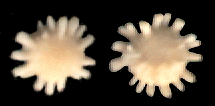|
Discussions:
-
That seems to be species
of Echinodermata ( Sea Star or Holothuroids)
Saludos, Jose H.
-
The odd round object
with lobes I don't think is a foram... haven't seen anything remotely
like it, and banthics (anything about 2mm or more would HAVE to
be a banthic ie bottom-dwelling foram) but it could possibly be
an echinoderm ossicle. Forams always show signs of chambering, with
an aperture. Not all show visible foramina (the tiny openings through
which many protrude pseudopods). Benthics tend to lack foramina
anyway. Andrew G
-
The mystery
object is a starfish skeletal element. I often see echinoderm and
sponge skeletal elements mixed with "grunge" - some are
quite beautiful. GTW
-
I suppose these are
the same as sclerites the "mysterious" critters from the
Pre Cambrian and Cambrian. Emilio P.
-
In regards to echinoderm
ossicles:
"One place to find them is on the Tree of Life web site www.tolweb.org
Following the echinoderm branch to sea cucumbers leads to the Alexander
M. Kerr page where photos of ossicles are included...Joan Jass"
-
Concerning
this item , the object currently ID'ed as an echinoderm ossicle,
I strongly suspect that it is the benthic foram Calcarina. Calcarina
is a relatively common foram of reef flat environments in the Indo-Pacific,
but it most common in the south Pacific. If you are interested,
I could look at my copy of the report on forams of Hawaii.
Also, it just does not look right to be an echinoderm ossicle, either
from a starfish or a sea cucumber. T.Y.
|
